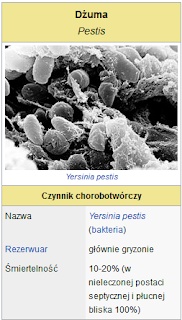What Is Dzuma Dzuma Baby Story Meaning ?
It's Very Fantastic about Dzuma Dzuma Baby Story Meaning in the world. Now you can read more article about this in blog. Firs step you must know how many factor to make this is ?
1. etiological factor
Plague causes stationary rod, ribbon negatively using the method Gram nieprzetrwalnikujaca, Yersinia pestis. This bacterium has a team of genes called Yop virulon producing special tabs protein on the surface of the bacterial cell and endotoxin. With these knobs are recognized phagocytes infected organism and are introduced into the cytoplasm of bacterial endotoxins phagocytes (YopE, and YopH YopT) that block the phagocytosis. This pathogen is sensitive to common disinfectants (chemical and high temperature). It has a relatively high resistance to low temperatures. In an environment experiencing usually from month to half a year.
2. Pathogenesis, symptoms and recognition
Symptoms of bubonic plague (lat. Pestis Bubonic) emerge from two days to a week from the bite. In the initial period, the first 6-8 hours, non-specific symptoms such as high fever (above 38 C), sweats, chills, vasodilation, headache and severe weakness.
Then there is enlargement of the lymph nodes (up to approx. 10 cm), especially the fillet, rarely axillary, cervical or other symptoms and inflammation of the lymphatic vessels. Enlarged lymph nodes become painful (sometimes causing limb contractures), soft (due to necrosis of the mechanism of heart attack and purulent changes in the central parts thereof), their contents can be emptied by spontaneous fistula. In mild cases of bubonic plague (lat. Pestis minor) disease process is limited to one group of lymph nodes, even without formation of fistulas. Usually, however, are secondary bubo (occupied are more groups of lymph nodes). In rare cases, model kebaya wisuda bubonic changes occur only in deep lymph nodes. Such cases are very difficult to recognize, like the course of severe forms of typhoid fever or severe form – septic plague.
Form septic (lat. Pestis septica) has, in addition to nonspecific symptoms, a large bacteraemia. As a result of systemic infection, as a reaction macroorganism, there is a generalized inflammatory syndrome (lat. Sepsis). As a result, created microembolism bacterial end the blood vessels of the fingers and toes and nose, resulting in gangrene (manifested black staining of tissue). These symptoms are similar to descriptions of the epidemic “Black Death” of the Middle Ages. In this embodiment, the prognosis is very serious.
In the form of pulmonary (lat. Pestis pneumonic) symptoms of severe, exudative pneumonia with hemoptysis, shortness of breath and cyanosis. The prognosis is much worse than the bubonic form. Pulmonary anthrax is characterized by an unusual contagious through droplets (without the mediation of fleas).
Pneumonia plague is a haemorrhagic, intrabronchial inflammation with erythrocyte croupus effusion.
Early diagnosis is based on an interview with epidemiological and clinical study. To confirm plague used bacteriological cultures of material from the lymph nodes, blood or sputum. Also important they are serological methods and PCR. Final confirmation is done in laboratories with high (3, 4) Degree biosafety.
Treatment
Treatment involves administration of parenteral antibiotics. The bacteria are sensitive to streptomycin, gentamicin, chloramphenicol (the first two antibiotics are known. Drugs of choice for the treatment of plague. Chloramphenicol, despite the very high efficiency, is currently used as antibiotic “second-line”, because of the frequent and dangerous side effects) , ciprofloxacin, cephalosporins (in pulmonary and systemic plague) and some tetracycline, doxycycline most often (in mild cases). Large importance of a supportive treatment; the need to develop surgical bubo is rare.
In Poland, sick of the plague are subject to forced hospitalization. Prognosis In untreated cases, on the basis of data from various epidemics, mortality from bubonic form is estimated to be several to up to 80% Untreated form of septic (septicemic) and pulmonary plague is 100% lethal (death as pulmonary usually occurs within a few days, as septiceaemic even within 48 hours) [2]
Proper and early started antibiotics reduces the mortality in the form of bubonic less than 5%, in the form of septic pulmonary and less than 20% (with the proviso that the treatment is made during the first day after the onset of disease symptoms). Prevention. Prevention consists of avoiding contact with dead wild animals and situations in which may be bitten by a rodent (eg. During feeding); use of anti-fleas in domestic animals.
The first vaccine against plague developed in 1890. Is commercially available vaccine against plague which comprises formalin-killed bacteria. It provides protection against bubonic form, but its effectiveness in preventing pulmonary embodiment is small [3]. For any embodiment except the pulmonary insulation of contacts is not needed, as antibiotic prophylaxis.
History Dzuma Baby Story
Apollo strikes headed swine, illustration for the Iliad; Stanislaw Wyspianski, 1897 Originally the Latin word pestis was one of the many general terms “plague” or “mass misery”, “destruction”. Only in the XV-XVI. They began to distinguish between different types of diseases that cause massive disease epidemic fatal. This word has a vague origin, it may be akin to Latin. perdo – “lost, destroyed, wasted,” Lat. perditus – “lost, incurable, hopeless.”
Protective clothing physician during the plague epidemic (Germany, the seventeenth century.)
There are disputes whether one of the first descriptions of epidemic given by Thucydides called. “Plague of Athens” in 430 BC It was actually plague (it is possible that it was typhoid, dengue, smallpox and hemorrhagic fever virus). From ancient times through the Middle Ages up to modern times is described dozens of major epidemics (most likely) the plague, also known as “Black Death” (from emerging extensive necro-zgorzelinowych in the skin, taking a dark color).

Most often it occurs among both animals and humans, bubonic form of the plague. Infection occurs usually as a result of bites by fleas (mostly rat flea, Xenopsylla cheopis) previously infected by the bite of rats, squirrels, nieswiszczukw czarnoogonowych or other small mammals. Following infection, bacteria migrate through the blood and lymph nodes and after approximately five days revealed enlargement of regional organ (the. Bubo). Form of bubonic plague caused may also be ingestion of contaminated food or water (rare in humans).
The figure is usually a septic complication of bubonic plague. In some patients develop, bypassing the bubonic form, once the initial sepsis. Cardiac form of plague can occur either as a primary infection (in this case it takes place by droplet from person to person, with the exception of the vector infection as fleas, rat) or as a secondary dzumowe pneumonia as a complication of which bubonic. This embodiment is characterized by very high contagiousness (unknown to science are, however, cases of pneumonic plague infections by eg. The ventilation system).
